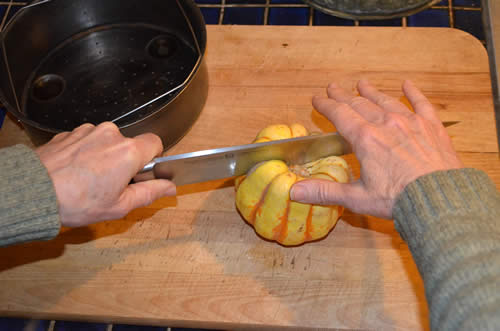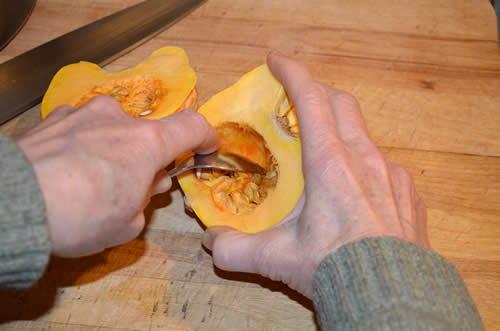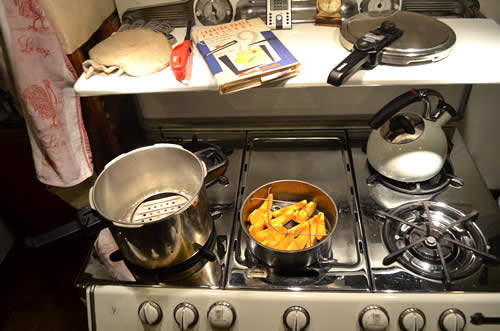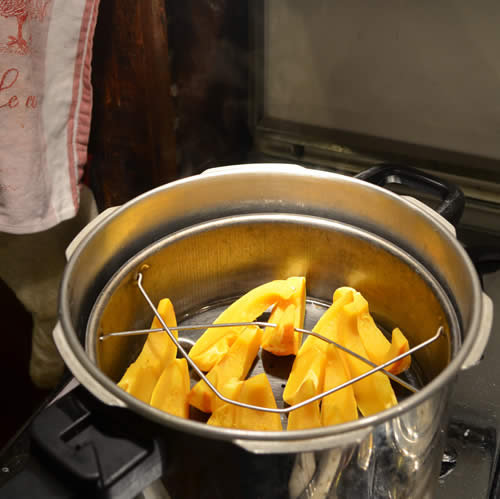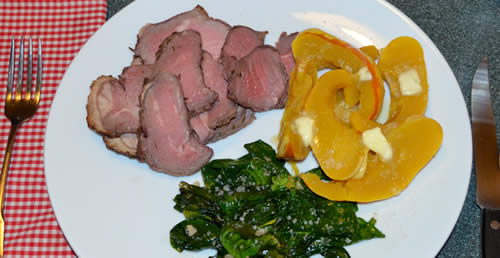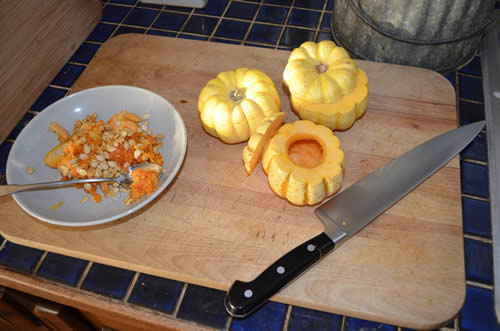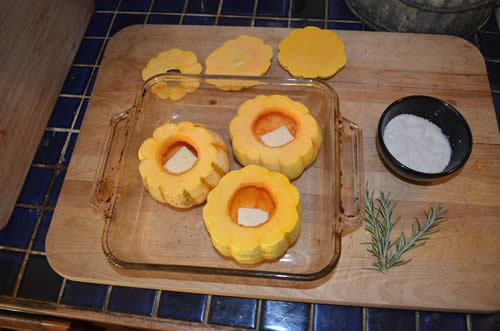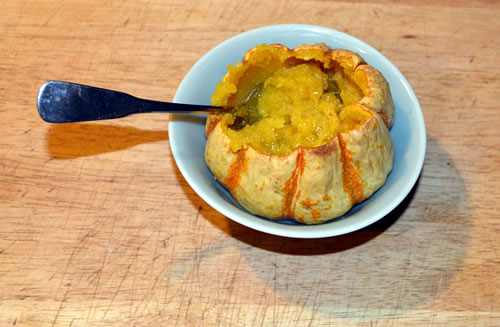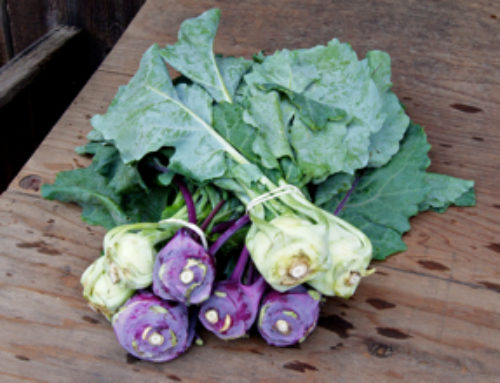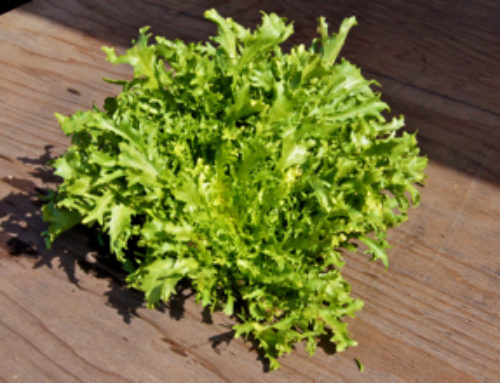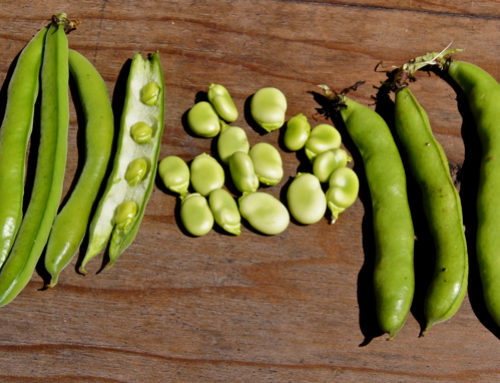Hi everybody! Welcome to 2013, and to my new Debbie’s Kitchen 2.0 blog — folks at the farm say members have been missing me, so I’m coming back. For those of you who don’t know me, my goal is to educate and entertain, while at the same time helping you to become comfortable using “what’s in the box”. For me, cooking and eating is a joy. Every day. And I hope to pass that joy along. It’s all about the ingredients, really. When you have good ingredients — fresh from the farm, nurtured in healthy soil, such as you get in your CSA box — you can’t go wrong. It’s just a matter of learning how to use them. Over time, via this blog, I hope to demonstrate how easy this can be. Make it all as accessible as possible.
Cheers!
Debbie
PS – I will gladly take questions or comments and respond to them in this blog, so feel free to email me at any time.
Ooohhh-kay, here goes! This week, I’m going to focus on Sweet Dumpling squash. Next week, look for scuttlebutt on the new Curly Kale. Enjoy!
————————————————-
Now I know we’re supposed to be getting Butternut squash this week, but if you’re like most people (i.e. like me), you still have extras of these guys (the Sweet Dumplings) hanging around your kitchen, waiting to be loved. We all are familiar with Butternut — it’s a very accessible winter squash, reliable, tasty, can’t go wrong — but the Sweet Dumplings are bigger strangers to us. A little off-putting, with their lumpy, unassuming, hard-to-peel exterior. Let’s see if I can’t shine a little love on these guys.
To start with — are you ready? You don’t need to peel them at all.
Yeah, I too was once of the mind that all winter squash needed peeling. Is it an American thing, this impetus to peel? Don’t know. I have gone the peel-them route with Sweet Dumplings and it IS do-able… but geez, talk about a pain in the patootie! All those ridges, trying to peel the bits down in the crevices; you have to cut them into pieces and then peel the pieces… ugh! Takes forEVER. And then there’s the risk to life-and-limb (okay, to our knuckles, anyway) when using a sharp object (peeler) against an awkward surface. Slip, slice – ouch!! Band-aid time. So the formula goes something like this: Peeling Sweet Dumplings = Time consuming + Risky. It’s this formula which explains why we tend to use them as centerpieces but avoid them in our diet. But the formula is based on faulty data, cuz you don’t need to peel them at all.
Oh, and are you ready for more? You can eat the peel too! Think: baked potato. You don’t have to, of course, and there’re times I do and times I don’t (just like with potatoes), but don’t assume it is not edible.
Okay, that being said, here are two simple ways to prepare them. One where you eat the peel, one where you don’t. One which is quick, one which takes longer… but only in the cooking time, not the preparation time. Neither involves peeling.
Sweet Dumpling Slices Steamed in a Pressure Cooker
Takes about 15 minutes, including preparation and cooking time. (No pressure cooker? No problem. You can steam ’em in a regular steamer; just takes longer.)
Since in this case I’m gonna eat the peel, I like to give the squashes a little scrub with my veggie brush, remove any dirt or skoogie stuff. Then comes cutting it up (remember, no peeling – yay!). These babies are hard, so keep fingers safely out of the way! There’s a trick to cutting out the stem area too; for god’s sake don’t try to do this like you do when carving a jack-o-lantern – you WILL injure yourself. Start by cutting ’em in half. Set them on a hard, stable surface to do this. Keep your fingers safely out of the way!
Scoop out the seeds and stringy slimy gook in the interior. [What to do with the insides? Talk to Rebecca; I’m sure you can toast the seeds if you want to. Or compost them. I feed them to my chickens.]
Then quarter them (put halves flat-side down to do this – much easier), THEN you can easily cut away the stem area from the quarters (and the knobby little blossom end as well). If the squash has its stem intact, snap it off by holding the squash firmly in both hands and pushing with your thumb(s). If it doesn’t want to give, a pair of pliers should do the trick. Do this before halving and quartering — it’s nigh impossible to cut through the stem.
Okay so now you’ve got four, clean squash quarters (or eight, or sixteen, depending on how many squash you’re cooking). These are relatively easy to cut further into wedges; cut each quarter into roughly a half-inch thick wedges (depends on how big the squash are).
Place cut up squash in the basket of your pressure cooker, but don’t stick the basket into the cooker itself until the water is boiling. The basket should be elevated above the level of water in the bottom of the cooker, just like for a steamer. Close and lock lid, then when the cooker comes to full pressure (when steam is escaping from the valve) — that’s when you start your timer.
Cook the wedges at full pressure for about 4 minutes. Quick-release the pressure by running cold water over the cooker in your sink. Remove lid and check for doneness; it should pierce easily with the tip of a sharp knife; no resistance. If you don’t think it’s done enough, lock the lid back in place and cook another minute.
You can serve the squash immediately or keep it warm while you prepare the rest of dinner; it’s not so fragile. During cooking, its nutty, sweet aroma fills the kitchen; really pleasant on these brrr-chilly nights! Be sure to serve it hot, so that butter melts easily on it. Sprinkle with a little salt to bring out its sweetness. That’s it! Of course there are all sorts of ways to gussy foods up before eating them, but I often enjoy meals where the food is served very simply, so I can enjoy the flavor of the items themselves. And remember, the steam pressure has rendered the skin tender enough to eat right along with the squash.
Baked Whole Sweet Dumplings
Takes about 1 hr 45 min, but only 10 – 15 minutes of that is prep; the rest is just time in the oven. This is a good “slow food” dish…
If you bake Sweet Dumplings, rather than steam them (as above), the peel dries and becomes a vessel for holding the sweet, creamy flesh; in this case I don’t generally eat the peel (though you certainly can if you like).
No need to remove the stem in this case. Turn squash on its side and cut off the top quarter or so; save the top – you’ll use it as a lid. Scoop out the insides, put a pat of butter (a tablespoon, more or less) inside the cavity, sprinkle in some salt, and (optionally) tuck in a sprig of fresh rosemary. Set the top back in place.
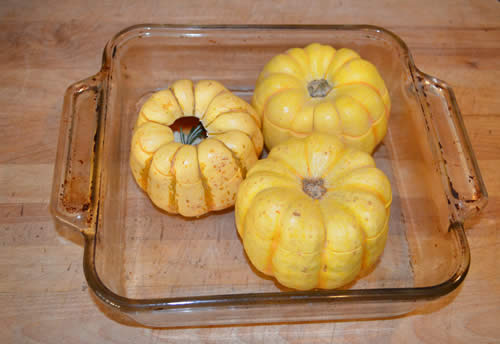
(On one of the squash I cut the the top a little too shallow; the stem was set deep – hence the “peep-hole” in the lid!)
Put thus prepared squashes (do as many as you like) in a baking dish, pour a little water in the bottom, and bake in a preheated 325 – 350 degree F oven for about an hour and a half. This is the “slow food” part… you don’t want to rush them; if they’re underdone and still firm, eh… not so good. But when they’re baked long and slow, they are just delicious! The test for doneness is simple: they should give easily when squeezed with the fingertips, like a soft loaf of bread. Be quick with your squeeze test though — remember, they’re hot! I don’t want any scorched fingers!

(I baked these in my toaster oven, so the tops were pretty close to the heating elements. But the “lids” keep the tender flesh inside from drying out, so no big deal.)
The baked Sweet Dumplings, like their steamed siblings, also “keep” well; not like a touchy souffle that must be served immediately. Just cover the baking dish with foil after removing from the oven. You can even keep them on “standby” in the still-warm oven for an hour or more.
When you go to eat them, just remove and discard the rosemary sprig, which has now imparted its perfume to the butter and flesh of the squash; scrape the squash away from the sides of the skin and mix it around with the pool of melted butter inside; the peel acts like a bowl to hold the squash, which works nicely for serving – each eater can have their own squash!
And it doesn’t show in the picture (‘cuz I only just started the scraping process when I took it), but by the time I’m done eating I will have scraped the flesh all the way down to it’s papery exterior, to the point where it becomes translucent; an empty husk. Don’t want to miss one morsel of its yumminess!


